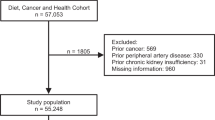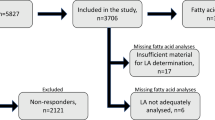Abstract
Background/Objectives:
Numerous studies reported beneficial effects of marine n-3 fatty acids (n-3 FAs) on cardiovascular disease (CVD) and its risk factors. However, the association of marine n-3 FAs with plasma fibrinogen, a risk factor for CVD, remains uncertain.
Subjects/Methods:
In a population-based, cross-sectional study of 795 men aged 40–49 without CVD (262 whites in Allegheny County, Pennsylvania, USA, 302 Japanese in Kusatsu, Japan and 229 Japanese Americans in Honolulu, Hawaii, USA), we examined the association of marine n-3 FAs with plasma fibrinogen. Serum FAs were measured by capillary gas–liquid chromatography. Marine n-3 FAs were defined as the sum of docosahexaenoic, eicosapentaenoic and docosapentaenoic acids. Plasma fibrinogen was measured by an automated clot-rate assay. Multiple linear regression analyses were performed to assess the association.
Results:
White, Japanese and Japanese-American men had mean marine n-3 FAs levels of 3.47%, 8.78% and 4.46%, respectively. Japanese men had a significant inverse association of marine n-3 FAs with fibrinogen (standardized regression coefficient of −0.11, P=0.049), after adjusting for age, body-mass index and current smoking. The significant inverse association remained after further adjusting for diabetes, C-reactive protein, triglycerides and other variables. White or Japanese-American men did not show a significant association.
Conclusions:
We observed the significant inverse association of marine n-3 FAs with fibrinogen in Japanese, but not in whites or Japanese Americans. The observation suggests that marine n-3 FAs at very high levels, as seen in the Japanese, may decrease plasma fibrinogen levels.
This is a preview of subscription content, access via your institution
Access options
Subscribe to this journal
Receive 12 print issues and online access
$259.00 per year
only $21.58 per issue
Buy this article
- Purchase on Springer Link
- Instant access to full article PDF
Prices may be subject to local taxes which are calculated during checkout
Similar content being viewed by others
References
Abbott RD, Ueshima H, Rodriguez BL, Kadowaki T, Masaki KH, Willcox BJ et al. (2007). Coronary artery calcification in Japanese men in Japan and Hawaii. Am J Epidemiol 166, 1280–1287.
Archer SL, Green D, Chamberlain M, Dyer AR, Liu K (1998). Association of dietary fish and n-3 fatty acid intake with hemostatic factors in the Coronary Artery Risk Development in Young Adults (CARDIA) Study. Arterioscler Thromb Vasc Biol 18, 1119–1123.
Balk E, Chung M, Lichtenstein A, Chew P, Kupelnick B, Lawrence A et al. (2004). Effects of Omega-3 Fatty Acids on Cardiovascular Risk Factors and Intermediate Markers of Cardiovascular Disease. Evidence Report/Technology Assessment no. 93, vol. no. 93. Agency for Healthcare Research and Quality: Rockville, MD.
Balk EM, Lichtenstein AH, Chung M, Kupelnick B, Chew P, Lau J (2006a). Effects of omega-3 fatty acids on coronary restenosis, intima-media thickness, and exercise tolerance: a systematic review. Atherosclerosis 184, 237–246.
Balk EM, Lichtenstein AH, Chung M, Kupelnick B, Chew P, Lau J (2006b). Effects of omega-3 fatty acids on serum markers of cardiovascular disease risk: a systematic review. Atherosclerosis 189, 19–30.
Bang HO, Dyerberg J, Nielsen AB (1971). Plasma lipid and lipoprotein pattern in Greenlandic West-coast Eskimos. Lancet 1, 1143–1145.
Bots ML, Elwood PC, Salonen JT, Freire de Concalves A, Sivenius J, Di Carlo A et al. (2002). Level of fibrinogen and risk of fatal and non-fatal stroke. EUROSTROKE: a collaborative study among research centres in Europe. J Epidemiol Community Health 56 (Suppl 1), i14–i18.
Cobiac L, Clifton PM, Abbey M, Belling GB, Nestel PJ (1991). Lipid, lipoprotein, and hemostatic effects of fish vs fish-oil n-3 fatty acids in mildly hyperlipidemic males. Am J Clin Nutr 53, 1210–1216.
Danesh J, Lewington S, Thompson SG, Lowe GD, Collins R, Kostis JB et al. (2005). Plasma fibrinogen level and the risk of major cardiovascular diseases and nonvascular mortality: an individual participant meta-analysis. JAMA 294, 1799–1809.
Dyerberg J, Bang HO, Hjorne N (1975). Fatty acid composition of the plasma lipids in Greenland Eskimos. Am J Clin Nutr 28, 958–966.
Gervois P, Vu-Dac N, Kleemann R, Kockx M, Dubois G, Laine B et al. (2001). Negative regulation of human fibrinogen gene expression by peroxisome proliferator-activated receptor α agonists via inhibition of CCAAT box/enhancer-binding protein β. J Biol Chem 276, 33471–33477.
Grundt H, Nilsen DW, Hetland O, Mansoor MA, Aarsland T, Woie L (1999). Atherothrombogenic risk modulation by n-3 fatty acids was not associated with changes in homocysteine in subjects with combined hyperlipidaemia. Thromb Haemost 81, 561–565.
Harris WS, Miller M, Tighe AP, Davidson MH, Schaefer EJ (2008). Omega-3 fatty acids and coronary heart disease risk: clinical and mechanistic perspectives. Atherosclerosis 197, 12–24.
He K, Rimm EB, Merchant A, Rosner BA, Stampfer MJ, Willett WC et al. (2002). Fish consumption and risk of stroke in men. JAMA 288, 3130–3136.
Hill AM, Buckley JD, Murphy KJ, Howe PR (2007). Combining fish-oil supplements with regular aerobic exercise improves body composition and cardiovascular disease risk factors. Am J Clin Nutr 85, 1267–1274.
Iso H, Folsom AR, Sato S, Wu KK, Shimamoto T, Koike K et al. (1993). Plasma fibrinogen and its correlates in Japanese and US population samples. Arterioscler Thromb 13, 783–790.
Kagan A, Harris BR, Winkelstein Jr W, Johnson KG, Kato H, Syme SL et al. (1974). Epidemiologic studies of coronary heart disease and stroke in Japanese men living in Japan, Hawaii and California: demographic, physical, dietary and biochemical characteristics. J Chronic Dis 27, 345–364.
Krebs JD, Browning LM, McLean NK, Rothwell JL, Mishra GD, Moore CS et al. (2006). Additive benefits of long-chain n-3 polyunsaturated fatty acids and weight-loss in the management of cardiovascular disease risk in overweight hyperinsulinaemic women. Int J Obes 30, 1535–1544.
Marchioli R, Levantesi G, Silletta MG, Barlera S, Bernardinangeli M, Carbonieri E et al. (2009). Effect of n-3 polyunsaturated fatty acids and rosuvastatin in patients with heart failure: results of the GISSI-HF trial. Expert Rev Cardiovasc Ther 7, 735–748.
Matthews KA, Sowers MF, Derby CA, Stein E, Miracle-McMahill H, Crawford SL et al. (2005). Ethnic differences in cardiovascular risk factor burden among middle-aged women: Study of Women's Health Across the Nation (SWAN). Am Heart J 149, 1066–1073.
Miura K, Nakagawa H, Ueshima H, Okayama A, Saitoh S, Curb JD et al. (2006). Dietary factors related to higher plasma fibrinogen levels of Japanese-Americans in Hawaii compared with Japanese in Japan. Arterioscler Thromb Vasc Biol 26, 1674–1679.
Mori TA, Bao DQ, Burke V, Puddey IB, Watts GF, Beilin LJ (1999). Dietary fish as a major component of a weight-loss diet: effect on serum lipids, glucose, and insulin metabolism in overweight hypertensive subjects. Am J Clin Nutr 70, 817–825.
Motoyama KR, Curb JD, Kadowaki T, El-Saed A, Abbott RD, Okamura T et al. (2009). Association of serum n-6 and n-3 polyunsaturated fatty acids with lipids in 3 populations of middle-aged men. Am J Clin Nutr 90, 49–55.
Mozaffarian D, Rimm EB (2006). Fish intake, contaminants, and human health: evaluating the risks and the benefits. JAMA 296, 1885–1899.
Nakamura Y, Ueshima H, Okamura T, Kadowaki T, Hayakawa T, Kita Y et al. (2005). Association between fish consumption and all-cause and cause-specific mortality in Japan: NIPPON DATA80, 1980–99. Am J Med 118, 239–245.
Niu K, Hozawa A, Kuriyama S, Ohmori-Matsuda K, Shimazu T, Nakaya N et al. (2006). Dietary long-chain n-3 fatty acids of marine origin and serum C-reactive protein concentrations are associated in a population with a diet rich in marine products. Am J Clin Nutr 84, 223–229.
Nordoy A, Bonaa KH, Sandset PM, Hansen J-B, Nilsen H (2000). Effect of \{omega\}-3 fatty acids and simvastatin on hemostatic risk factors and postprandial hyperlipemia in patients with combined hyperlipemia. Arterioscler Thromb Vasc Biol 20, 259–265.
Ohsawa M, Itai K, Onoda T, Tanno K, Sasaki S, Nakamura M et al. (2008). Dietary intake of n-3 polyunsaturated fatty acids is inversely associated with CRP levels, especially among male smokers. Atherosclerosis 201, 184–191.
Radack K, Deck C, Huster G (1989). Dietary supplementation with low-dose fish oils lowers fibrinogen levels: a randomized, double-blind controlled study. Ann Intern Med 111, 757–758.
Rosenson RS, Tangney CC (1998). Antiatherothrombotic properties of statins: implications for cardiovascular event reduction. JAMA 279, 1643–1650.
Saynor R, Gillott T (1992). Changes in blood lipids and fibrinogen with a note on safety in a long term study on the effects of n-3 fatty acids in subjects receiving fish oil supplements and followed for seven years. Lipids 27, 533–538.
Sekikawa A, Curb JD, Ueshima H, El-Saed A, Kadowaki T, Abbott RD et al. (2008). Marine-derived n-3 fatty acids and atherosclerosis in Japanese, Japanese-American, and white men: a cross-sectional study. J Am Coll Cardiol 52, 417–424.
Sekikawa A, Ueshima H, Kadowaki T, El-Saed A, Okamura T, Takamiya T et al. (2007). Less subclinical atherosclerosis in Japanese men in Japan than in White men in the United States in the post-World War II birth cohort. Am J Epidemiol 165, 617–624.
Shahar E, Folsom AR, Wu KK, Dennis BH, Shimakawa T, Conlan MG et al. (1993). Associations of fish intake and dietary n-3 polyunsaturated fatty acids with a hypocoagulable profile. The Atherosclerosis Risk in Communities (ARIC) Study. Arterioscler Thromb 13, 1205–1212.
Stamler J, Elliott P, Chan Q, for the INTERMAP Research Group (2003a). Intermap appendix tables. J Hum Hypertens 17, 665–775.
Stamler J, Elliott P, Dennis B, Dyer AR, Kesteloot H, Liu K et al. (2003b). INTERMAP: background, aims, design, methods, and descriptive statistics (nondietary). J Hum Hypertens 17, 591–608.
Takahashi M, Tsuboyama-Kasaoka N, Nakatani T, Ishii M, Tsutsumi S, Aburatani H et al. (2002). Fish oil feeding alters liver gene expressions to defend against PPARalpha activation and ROS production. Am J Physiol Gastrointest Liver Physiol 282, G338–G348.
The Fibrinogen Studies Collaboration (2007). Associations of plasma fibrinogen levels with established cardiovascular disease risk factors, inflammatory markers, and other characteristics: individual participant meta-analysis of 154,211 adults in 31 prospective studies. Am J Epidemiol 166, 867–879.
Toft I, Bonaa KH, Ingebretsen OC, Nordoy A, Jenssen T (1997). fibrinolytic function after dietary supplementation with {omega}3 polyunsaturated fatty acids. Arterioscler Thromb Vasc Biol 17, 814–819.
Ueshima H, Stamler J, Elliott P, Chan Q, Brown IJ, Carnethon MR et al. (2007). Food omega-3 fatty acid intake of individuals (total, linolenic acid, long-chain) and their blood pressure: INTERMAP Study. Hypertension 50, 313–319.
Vanschoonbeek K, Feijge MAH, Paquay M, Rosing J, Saris W, Kluft C et al. (2004). Variable hypocoagulant effect of fish oil intake in humans: modulation of fibrinogen level and thrombin generation. Arterioscler Thromb Vasc Biol 24, 1734–1740.
Wang C, Harris WS, Chung M, Lichtenstein AH, Balk EM, Kupelnick B et al. (2006). n-3 Fatty acids from fish or fish-oil supplements, but not alpha-linolenic acid, benefit cardiovascular disease outcomes in primary- and secondary-prevention studies: a systematic review. Am J Clin Nutr 84, 5–17.
Willett WC, Howe GR, Kushi LH (1997). Adjustment for total energy intake in epidemiologic studies. Am J Clin Nutr 65, 1220S–11228.
Yano K, Kodama K, Shimizu Y, Chyou P-H, Sharp DS, Tracy RP et al. (1999). plasma fibrinogen and its correlates in elderly japanese men living in Japan and Hawaii. J Clin Epidemiol 52, 1201–1206.
Yoneyama S, Miura K, Sasaki S, Yoshita K, Morikawa Y, Ishizaki M et al. (2007). Dietary intake of fatty acids and serum C-reactive protein in Japanese. J Epidemiol 17, 86–92.
Zhang J, Sasaki S, Amano K, Kesteloot H (1999). Fish consumption and mortality from all causes, ischemic heart disease, and stroke: an ecological study. Prev Med 28, 520–529.
Acknowledgements
This research was supported by Grants R01 HL68200 and HL071561 from the National Institutes of Health, B 16790335 and A 13307016 from the Japanese Ministry of Education, Culture, Sports, Science and Technology.
Author information
Authors and Affiliations
Consortia
Corresponding author
Ethics declarations
Competing interests
The authors declare no conflict of interest.
Rights and permissions
About this article
Cite this article
Hassen, L., Ueshima, H., Curb, J. et al. Significant inverse association of marine n-3 fatty acids with plasma fibrinogen levels in Japanese in Japan but not in whites or Japanese Americans. Eur J Clin Nutr 66, 329–335 (2012). https://doi.org/10.1038/ejcn.2011.155
Received:
Revised:
Accepted:
Published:
Issue Date:
DOI: https://doi.org/10.1038/ejcn.2011.155



